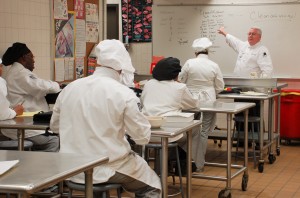
Late nights. Standing for 14 hours straight in cramped, hot kitchens. Those conditions are some of the defining characteristics of a career as a restaurant chef. While some people might view those job conditions in a negative light – whether at five-star restaurants or at mom-and-pop eateries in strip malls – chefs whose passions are cooking, service and hospitality see them as only a small part of what can be a very rewarding career path.
Those working conditions and long hours associated with restaurant work have led to a national shortage of trained cooks and chefs, according to various news reports. Jim Knifong, culinary arts instructor in the Food and Hospitality Institute at El Centro College, one of the colleges the Dallas County Community College District system, said the shortage affects both the U.S. and Europe.
In the United States, and Texas in particular, the numbers are startling. While restaurant jobs are expected to grow nationally by 12 percent over the next decade, in Texas that figure is 22 percent – the third-fastest in the nation, according to an industry forecast from the National Restaurant Association. The association found that one of the biggest challenges for restaurant operators is finding and retaining employees, especially during an improving economy.
Knifong said the glamorization of the industry – two cable TV channels devoted to cooking plus a multitude of chef competition shows on other channels, for example – does not reflect the reality of the hospitality industry. “We get a lot of students who see that, and that’s why they want to get into this. They think, ‘That’s what I want to do!’” he said. “That isn’t what the industry is. That’s TV. That’s not what cooking really is.”
Nathan Tate, executive chef and co-owner of two highly-acclaimed Dallas restaurants, Boulevardier and Rapscallion, and who also is a 2002 graduate of El Centro’s Food and Hospitality Institute, said people who go into the industry should be passionate about food, but they should expect to work hard and do some “repetitive, mundane things for years.” He added that prospective chefs need to “work their way up to sous chef and executive chef. That’s when it really starts being fun and when the pay becomes a good wage.”
Knifong said he understands why some people are turned off by the demands of the job as a restaurant cook, but people in the industry do it because they are passionate about food. “You do it because you enjoy it. It’s not a 9 to 5 job, sitting in an office. It’s not staring into a computer screen. You do it because it’s fun, because it’s what you like to do. It’s not your normal, boring office job,” he added.
Ruby Johnson, a bakery student at El Centro’s FHI, said the prospect of hard work as a chef does not scare her at all. “It’s what you do,” she said, adding, “If you’re going to be in this industry, you’re going to miss holidays. You’re going to miss events with your family because you like what you’re doing. If you like what you’re doing, it’s worth it, and it’s very rewarding.” Johnson said she would like to become a pastry chef, but her ultimate goal is to have a food truck and provide catering services as well.
Tate said he chose to attend El Centro’s FHI because it was affordable, and he didn’t want to be stuck with high college debt, which he cited as another reason for the chef shortage. He said some students get bachelor’s degrees in culinary arts, and they might accumulate “massive student loans.” Then, after they graduate, they end up working in some of the lowest-paying jobs in the kitchen, which might discourage them from staying in the industry.
Tate said salaries for kitchen staff will have to change and added that his restaurants already are adapting to the new reality. “We pay $2 [per hour] more than we would have paid a couple of years ago. That cost has to be transferred somewhere. It’s going to hit the consumer eventually,” he added
Tate added there’s another factor that affects the shortage. He said he has seen a huge influx of new restaurants in North Texas, where people eat out more than in any other metropolitan area, according to a recent survey by the U.S. Bureau of Labor Statistics. As a result, he added, the shortage comes from both ends: the high number of restaurants looking for personnel and a scarcity of qualified cooks available to take some of the low-paying jobs.
Knifong said he can’t supply enough kitchen staff to local restaurants. He has been teaching at the institute for eight years, so he personally knows many chefs in the Dallas area. He said he gets calls every day from alumni who ask him for “cooks, sous chefs and chefs.”
Tate said he likes and enjoys the accolades of being a successful chef, but it’s not what drives him. He said he has enjoyed providing a “wonderful experience and a really good product to customers.”
Student chefs at El Centro’s FHI see the scarcity of cooks as an opportunity to step in and show off their cooking skills.
Jeremy Warwick, one of Knifong’s students, said some day he would like to open a southern cuisine restaurant. He sees the labor shortage as good news. “It means there are more positions for me to step into after I finish,” he added.
The walls leading to the kitchens at ECC’s Food and Hospitality Institute are lined with portraits of successful, well-known alumni of the program, and some students use those chefs’ stories as inspiration. Culinary arts student Kayla Spencer said, “They finished their degree plan, and now they’re role models we can look up to.”
For more information about the Food and Hospitality Institute at El Centro College, please email Steve DeShazo, director of the institute, at sdeshazo@dcccd.edu. To contact Jim Knifong, please email him at james.knifong@dcccd.edu.




